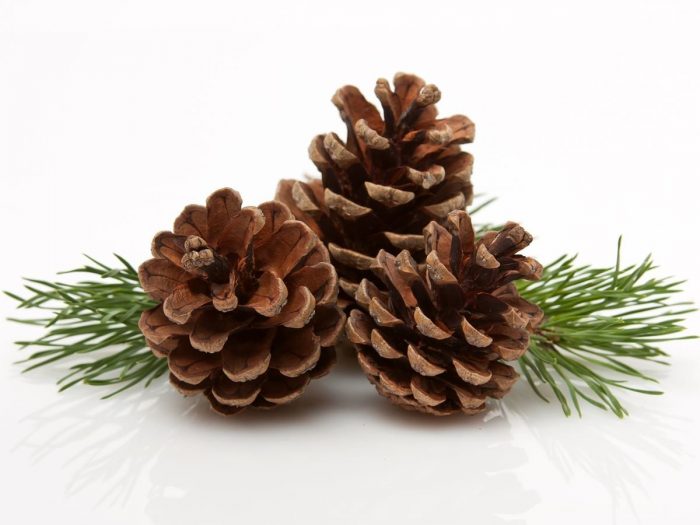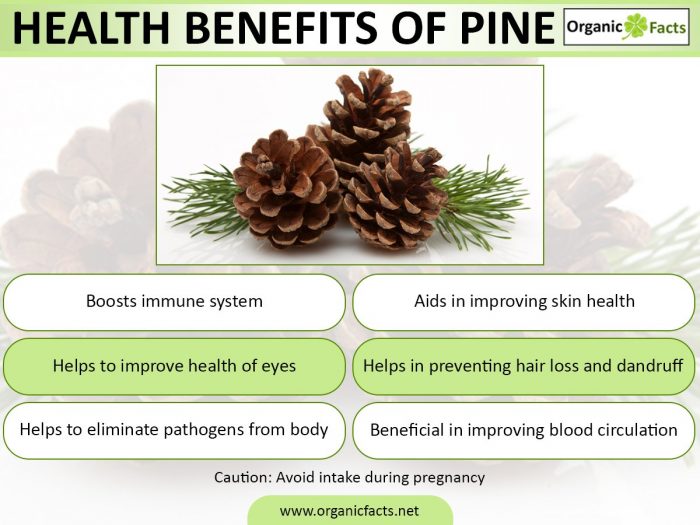Pine trees are one of our best-loved trees. The sloping branches have been immortalized in art and been part of our holiday traditions. But these are not just of aesthetic value. They are also used in many forms, from pine needle tea, essential oil, to its pollen. The different parts of the tree hold many health benefits.
What is Pine?
Pine is actually a broad term that encompasses around 120 different species of coniferous trees that fall within the Pinaceae family. You can find its species in most of the Northern hemisphere, but there is only one that is native to the southern hemisphere. While some species have been introduced to tropical climates for lumber or ornamental purposes, pines are very hardy and tend to become invasive in these regions. Hence, they are usually discouraged. These trees can have long lifespans, some stretching to 1,000 years of age. The oldest known pine tree in the world is in California. It is over 4,500 years old. [1]
In terms of medicinal benefits, pine needles, cones, bark, and resin all hold medicinal qualities. Its essential oil is also highly valued. The innermost bark can be dried and eaten. It is valued for its high nutrient content, while the needles can be brewed into a popular tea that has a number of beneficial qualities. You can read about the individual products in our articles: [2]
- 6 Proven Benefits of Pine Pollen
- Pine Needle Tea: How To Make It & Benefits
- 9 Amazing Benefits of Pine Essential Oil
Uses of Pine
- Its needles are used to brew tea.
- Its pollen is available as a powder and can be taken with drinks or added in baked goods.
- Pine cambium or the layer just beneath the outer bark can be eaten raw or cooked. Pine bark extract is also available commercially.
- The resin is used for skin care and treating wounds.
- Pine nuts are eaten widely.
- The sap is used as glue and for making candles.
- Wood is used extensively for making furniture and ornamental items.
Health Benefits of Pine
Pine and its various extracts are used in many ways in traditional medicine. While its parts like bark and pollen are more extensively researched, the benefits of pine needle tea are less known. However, these are used quite extensively in traditional medicine.
Possibly Rich in Antioxidants
Pine and its various constituents are known to be possibly rich in antioxidants, which may help to protect you against diseases. So, whether it is tea, bark extract, or pollen, as multiple researches have shown, you will get a good dose of immunity. The pollen extract was found to contain potent antioxidant and anti-inflammatory compounds. Similarly, different studies have validated the presence of antioxidants commercially available bark extracts, like flavangenol. A Berkley study found that the antioxidants in the bark were so potent that they could boost the effect of vitamin C and other antioxidants in our food.
 [3] [4] [5]
[3] [4] [5]
Pines are conifer trees mostly native to the northern hemisphere. Photo Credit: Shutterstock
May Improve Vision Health
Pine needle tea is believed to contain vitamin C and A, both of which help in improving vision. Even more powerful is the bark extract, which prevents damage to the eye. It proved highly effective against complications like diabetic retinopathy, a progressive condition where the retina of the eye gets damaged. [6] [7]
May Improve Skin & Hair Care
Vitamin A does a bit more than helping your vision; it may also prevent oxidative stress in your skin, helping to keep your skin looking young and wrinkle-free by eliminating free radicals. Furthermore, the vitamin C helps to speed the healing process and vitamin A reduces the appearance of blemishes and scars, even from skin conditions like acne. In terms of your hair, vitamin A and C both help give a rich luster to your locks and prevent hair loss and dandruff. [8]
Pine bark and essential oil have shown efficacy in dealing with various skin conditions in different studies. The essential oil is used in dermatology as an antiseptic for cuts, eczema, psoriasis, and sores. Pine bark extract was found to be photoprotective, preventing damage from skin exposure and aging. [9] [10]
May Protect Against Pathogens
Pine products are known for their protective properties, which are known to be effective in dealing with pathogens and microbes. The essential oil has potential antiseptic properties, which are used to treat wounds. It is used extensively for its antibacterial properties. You can find pure pine oil disinfectants that are used to kill viruses and bacteria. Some pine needles have also shown antibacterial properties in lab researches. The antibacterial properties of the bark extract have shown promise against multiple drug-resistant bacteria. The resin is well-known for its antimicrobial properties. It was used in many folk medicines to treat wounds.  [11] [12] [13] [14] [15]
[11] [12] [13] [14] [15]
Pine trees are cultural symbols all over the world. Photo Credit: Shutterstock
May Improve Circulation
Studies have shown that pine bark extract could improve blood circulation. A 2018 Italian study found it was effective in treating thrombosis, a condition where the blood starts to clot in the circulatory system. The needle extract, on the other hand, can lower blood cholesterol and improve blood circulation. [16]
May Maintain Respiratory Health
One of the most common applications of pine needle tea for treating respiratory conditions, such as inflammation of the respiratory tract, may help to relieve coughing and sore throats. It was used by the Native Americans as a nasal decongestant. A 2017 study found that the bark extract can be used to treat cigarette-induced chronic obstructive pulmonary diseases. [17] [18]
Word of Caution
The potent mix of chemicals and active ingredients in pine can be dangerous for pregnant women, as it has been known in some situations to cause miscarriages. Some species can be toxic when consumed. So, always get your pine needles and bark from a certified herbalist. Avoid picking needles in the wild if you don’t have any knowledge of the local flora and fauna. You can’t be sure what other environmental or atmospheric factors may have contaminated the needles or roots.
